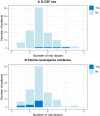Real-world evaluation of supportive care using an electronic health record text-mining tool: G-CSF use in breast cancer patients
- PMID: 36044088
- PMCID: PMC9633501
- DOI: 10.1007/s00520-022-07343-5
Real-world evaluation of supportive care using an electronic health record text-mining tool: G-CSF use in breast cancer patients
Abstract
Purpose: Chemotherapy-induced febrile neutropenia (FN) is a life-threatening and chemotherapy dose-limiting adverse event. FN can be prevented with granulocyte-colony stimulating factors (G-CSFs). Guidelines recommend primary G-CSF use for patients receiving either high (> 20%) FN risk (HR) chemotherapy, or intermediate (10-20%) FN risk (IR) chemotherapy if the overall risk with additional patient-related risk factors exceeds 20%. In this study, we applied an EHR text-mining tool for real-world G-CSF treatment evaluation in breast cancer patients.
Methods: Breast cancer patients receiving IR or HR chemotherapy treatments between January 2015 and February 2021 at LUMC, the Netherlands, were included. We retrospectively collected data from EHR with a text-mining tool and assessed G-CSF use, risk factors, and the FN and neutropenia (grades 3-4) and incidence.
Results: A total of 190 female patients were included, who received 77 HR and 113 IR treatments. In 88.3% of the HR regimens, G-CSF was administered; 7.3% of these patients developed FN vs. 33.3% without G-CSF. Although most IR regimen patients had ≥ 2 risk factors, only 4% received G-CSF, of which none developed neutropenia. However, without G-CSF, 11.9% developed FN and 31.2% severe neutropenia.
Conclusions: Our text-mining study shows high G-CSF use among HR regimen patients, and low use among IR regimen patients, although most had ≥ 2 risk factors. Therefore, current practice is not completely in accordance with the guidelines. This shows the need for increased awareness and clarity regarding risk factors. Also, text-mining can effectively be implemented for the evaluation of patient care.
Keywords: Breast cancer; Chemotherapy-induced febrile neutropenia; Clinical practice pattern; Granulocyte-colony stimulating factor; Text-mining.
© 2022. The Author(s).
Conflict of interest statement
The authors declare no competing interests.
Figures


References
MeSH terms
Substances
LinkOut - more resources
Full Text Sources
Medical
Miscellaneous

